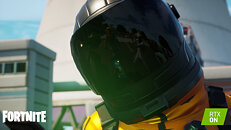Thursday, September 17th 2020

Fortnite Receiving NVIDIA RTX, DLSS, & Reflex Support on September 17th
Fortnite, one of the world's most popular games, is about to get faster, more beautiful, and even more responsive on PC with the addition of groundbreaking NVIDIA technologies. Ray-traced visual effects, NVIDIA DLSS, NVIDIA Reflex, and a custom RTX map will be added during Fortnite Chapter 2 - Season 4, thanks to a new Epic Games and NVIDIA partnership.
Immersive ray-traced effects, powered by GeForce RTX's RT Cores, dramatically improve the fidelity and detail of Fortnite's stylized world. With NVIDIA DLSS, performance is greatly accelerated thanks to Tensor Cores, found exclusively on GeForce RTX 20 and 30 Series GPUs. And NVIDIA Reflex reduces the time it takes for your actions, like your character's movements, to be displayed on your monitor, increasing responsiveness.
Update Sep 17th: NVIDIA has announced that these changes will be coming to the game on September 17 when a new GeForce Game Ready Driver is released.Ray Tracing Comes to Fortnite
Fortnite will add four ray-traced features, for a more immersive gaming experience. These include:
Using AI to Boost Performance and Image Quality in Fortnite
NVIDIA DLSS, which uses AI and is powered by RTX Tensor Cores, is a deep learning neural network that boosts frame rates and generates beautiful, sharp images for games. It provides gamers the performance headroom to maximize quality settings and increase output resolution.
NVIDIA Reflex Comes to Fortnite
Fortnite is one of the first games to support NVIDIA Reflex, which measures and reduces system latency. Reflex allows gamers to improve responsiveness, increase aiming precision and tune their system for battle.
"NVIDIA Reflex technology arms developers with new features to minimize latency in their games. We're seeing excellent responsiveness and player control with Fortnite running on the GeForce RTX 30 Series," said Nick Penwarden, vice president of Engineering at Epic Games.
System latency is the time it takes for a player's actions to appear as pixels on the monitor and quantifies how the game feels. In games like Fortnite, NVIDIA Reflex low-latency mode dynamically reduces system latency by up to 42 percent in GPU-bound scenarios.
New Fortnite RTX Treasure Run Map Spotlights Ray Tracing
NVIDIA and Epic collaborated with top Fortnite creators on the new RTX Treasure Run map, which highlights the new technologies Fortnite is adding. The map drops players at the entrance to a museum where they are challenged to a scavenger hunt that highlights different ray-traced effects.
Along the way, players can explore a hall of mirrors, medieval castle and jungle, climb a giant statue and explore a shrunken science lab to uncover the most treasures in the least amount of time. RTX Treasure Run is coming soon.
The new features are coming soon to Fortnite Chapter 2 - Season 4 for PC players and make Fortnite a flagship title for next-generation gaming technologies.
Complete Screenshots:Announcement Video:
Source:
NVIDIA
Immersive ray-traced effects, powered by GeForce RTX's RT Cores, dramatically improve the fidelity and detail of Fortnite's stylized world. With NVIDIA DLSS, performance is greatly accelerated thanks to Tensor Cores, found exclusively on GeForce RTX 20 and 30 Series GPUs. And NVIDIA Reflex reduces the time it takes for your actions, like your character's movements, to be displayed on your monitor, increasing responsiveness.
Update Sep 17th: NVIDIA has announced that these changes will be coming to the game on September 17 when a new GeForce Game Ready Driver is released.Ray Tracing Comes to Fortnite
Fortnite will add four ray-traced features, for a more immersive gaming experience. These include:
- Ray-traced reflections - Recreates the way light reflects on glossy and metal surfaces, including smooth natural mirrors like window glass and rougher surfaces like brushed metal.
- Ray-traced shadows - Accurately models shadowing on many surfaces while enhancing surface and contact detail, and fixes problems associated with traditional shadow techniques.
- Ray-traced global illumination - Calculates world lighting with massively increased precision, illuminating Fortnite's environments, players and characters with unprecedented detail, fidelity and clarity.
- Ray-traced ambient occlusion - Where objects or surfaces meet, light is occluded, creating subtle shadows that can highlight the slightest of surface details.
Using AI to Boost Performance and Image Quality in Fortnite
NVIDIA DLSS, which uses AI and is powered by RTX Tensor Cores, is a deep learning neural network that boosts frame rates and generates beautiful, sharp images for games. It provides gamers the performance headroom to maximize quality settings and increase output resolution.
NVIDIA Reflex Comes to Fortnite
Fortnite is one of the first games to support NVIDIA Reflex, which measures and reduces system latency. Reflex allows gamers to improve responsiveness, increase aiming precision and tune their system for battle.
"NVIDIA Reflex technology arms developers with new features to minimize latency in their games. We're seeing excellent responsiveness and player control with Fortnite running on the GeForce RTX 30 Series," said Nick Penwarden, vice president of Engineering at Epic Games.
System latency is the time it takes for a player's actions to appear as pixels on the monitor and quantifies how the game feels. In games like Fortnite, NVIDIA Reflex low-latency mode dynamically reduces system latency by up to 42 percent in GPU-bound scenarios.
New Fortnite RTX Treasure Run Map Spotlights Ray Tracing
NVIDIA and Epic collaborated with top Fortnite creators on the new RTX Treasure Run map, which highlights the new technologies Fortnite is adding. The map drops players at the entrance to a museum where they are challenged to a scavenger hunt that highlights different ray-traced effects.
Along the way, players can explore a hall of mirrors, medieval castle and jungle, climb a giant statue and explore a shrunken science lab to uncover the most treasures in the least amount of time. RTX Treasure Run is coming soon.
The new features are coming soon to Fortnite Chapter 2 - Season 4 for PC players and make Fortnite a flagship title for next-generation gaming technologies.
Complete Screenshots:Announcement Video:














12 Comments on Fortnite Receiving NVIDIA RTX, DLSS, & Reflex Support on September 17th
And then there's bragging rights when most popular titles on Earth support your tech ;) Ok, probably not Nvidia's tech, this will probably work on RDNA2 as well, but RTRT will remain in history as something spearheaded by Nvidia.
this isnt candycrush